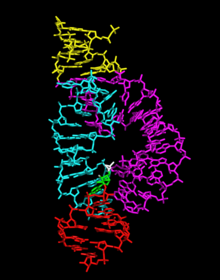
hammerhead ribozyme RNA molecule
The hammerhead ribozyme is an RNA motif that catalyzes reversible cleavage and ligation reactions at a specific site within an RNA molecule. It is one of several catalytic RNAs (ribozymes) known to occur in nature. It serves as a model system for research on the structure and properties of RNA, and is used for targeted RNA cleavage experiments, some with proposed therapeutic applications. Named for the resemblance of early secondary structure diagrams to a hammerhead shark,[1] hammerhead ribozymes were originally discovered in two classes of plant virus-like RNAs: satellite RNAs and viroids. They are also known in some classes of retrotransposons, including the retrozymes.[2] The hammerhead ribozyme motif has been ubiquitously reported in lineages across the tree of life.[3][4]
The self-cleavage reactions, first reported in 1986,[5][6] are part of a rolling circle replication mechanism. The hammerhead sequence is sufficient for self-cleavage[7] and acts by forming a conserved three-dimensional tertiary structure.
- ^ Forster AC, Symons RH (1987). "Self-cleavage of plus and minus RNAs of a virusoid and a structural model for the active sites". Cell. 49 (2): 211–220. doi:10.1016/0092-8674(87)90562-9. PMID 2436805. S2CID 33415709.
- ^ Cervera, Amelia; Urbina, Denisse; de la Peña, Marcos (2016). "Retrozymes are a unique family of non-autonomous retrotransposons with hammerhead ribozymes that propagate in plants through circular RNAs". Genome Biology. 17 (1): 135. doi:10.1186/s13059-016-1002-4. ISSN 1474-760X. PMC 4918200. PMID 27339130.
- ^ de la Peña, Marcos; García-Robles, Inmaculada (2010). "Ubiquitous presence of the hammerhead ribozyme motif along the tree of life". RNA. 16 (10): 1943–1950. doi:10.1261/rna.2130310. ISSN 1355-8382. PMC 2941103. PMID 20705646.
- ^ Hammann, Christian; Luptak, Andrej; Perreault, Jonathan; de la Peña, Marcos (2012). "The ubiquitous hammerhead ribozyme". RNA. 18 (5): 871–885. doi:10.1261/rna.031401.111. ISSN 1355-8382. PMC 3334697. PMID 22454536.
- ^ Prody GA, Bakos JT, Buzayan JM, Schneider IR, Bruening G (1986). "Autolytic Processing of Dimeric Plant Virus Satellite RNA". Science. 231 (4745): 1577–1580. Bibcode:1986Sci...231.1577P. doi:10.1126/science.231.4745.1577. PMID 17833317. S2CID 21563490.
- ^ Hutchins CJ, Rathjen PD, Forster AC, Symons RH (1986). "Self-cleavage of plus and minus RNA transcripts of avocado sunblotch viroid". Nucleic Acids Res. 14 (9): 3627–3640. doi:10.1093/nar/14.9.3627. PMC 339804. PMID 3714492.
- ^ Forster AC, Symons RH (1987). "Self-cleavage of virusoid RNA is performed by the proposed 55-nucleotide active site". Cell. 50 (1): 9–16. doi:10.1016/0092-8674(87)90657-X. PMID 3594567. S2CID 7231363.